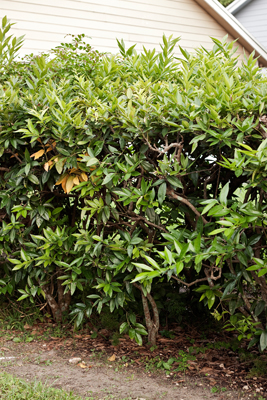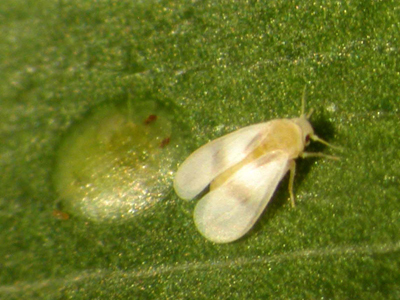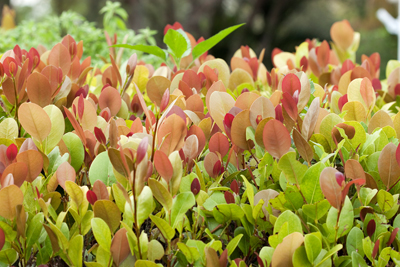Native plants make good hedges—usually

BY KENNETH SETZER
As published in the Miami Herald, 10/15/14.
Good fences make good neighbors, and so indeed do good hedges. But what makes a good hedge? While no plant is perfect, many types of plants can be grown and shaped into a properly dense and attractive hedge.
My original slant for this column was to promote using native instead of non-native plants for hedges, focusing on two hedges bordering my front yard: a native cocoplum (Chrysobalanus icaco) and a non-native ficus (Ficus benjamina). The ficus is fairly ragged, with many open areas allowing vines like creeping cucumber and balsam pear to take advantage of the sunlight. I thought this was all due to ficus whitefly, and I had hoped to use ficus as an example of bad landscaping.
But thanks to consulting with experts, I began to realize that the non-native shouldn’t necessarily be the worse choice. One reason non-natives can become invasive is because once removed from their native habitat, the predators and diseases that kept their numbers in check no longer exist in their new region.
So why does my ficus look so bad? New pest predators; whether they are native or imported, some creature will take advantage of the chance to eat. I believed I had a ficus whitefly infestation (Singhiella simplex), because I noticed bare areas denuded of foliage, sooty mold on the ficus leaves as well as a white, fluffy substance also associated with whitefly. The sooty mold grows on the honeydew that whiteflies and some other insects excrete. But after consulting with Catharine Mannion, Ph.D. (Professor and Extension Specialist at the University of Florida Tropical Research and Education Center in Homestead), I learned the ficus whitefly does not produce any of the fluffy, waxy matter, nor does it produce excessive amounts of honeydew “so you do not get the sooty mold growth as an indirect result of having ficus whitefly.”
Mannion clarified that “The whitefly that causes all the mess (white flocculent and honeydew that promotes the growth of sooty mold) is the rugose spiraling whitefly. (It) will feed on many different types of plants with gumbo limbo, coconuts, black olive, callophylum, and white bird of paradise as particular favorites. It . . . usually is not much of a problem on ficus.” Another whitefly, Bondar’s nesting whitefly (Paraleyrodes bondari), can cause a sooty mess and is found on ficus, however, Mannion indicates Bondar’s “overall is not a whitefly we are overly concerned about.”
Some whitefly species are notoriously difficult to distinguish and often need an expert in a lab to do so. The pests on the ficus looked to my untrained eye like immature whitefly, but Mannion recognized them as scale insects: “Immature scales and whiteflies can look similar. Ficus whitefly immature stages can be difficult to see because they are relatively flat and transparent. Shortly before they pupate they are a little more obvious. The most obvious stage is the pupal skin from which the adult emerges. It is white and oval and can stick on the leaf for quite awhile. The presence of these should not be used to make management decisions.”
Horticultural neem oil is sometimes used to kill whitefly, and in the case of scale insects, soapy water sprayed directly on infested leaves can temporarily help. For once, time is also one of our best allies. As whitefly species invade a new location, their natural predators and parasites are typically to follow. This has been the case with the rugose spiraling whitefly (Aleurodicus rugioperculatus), which can heavily infest gumbo limbo trees and others. Indeed, beetles, a parasitic wasp and lacewings have been observed attacking the whitefly, so avoid the spray insecticides that kill these allies.
For large-scale infestations of the sucking insects like whitefly and scale, systemic insecticides may be necessary. These are either applied to the soil or directly into the tree. I usually shy away from insecticides, but Mannion pointed out that “Applying them [systemic insecticides] to the soil or to the trunk is one way to decrease direct exposure to the good insects; i.e. natural enemies.” Since whiteflies feed from the plant itself, they consume the insecticide along with the plant juices, whereas a foliar spray exposes all animals, both harmful and beneficial.
“Also, if done appropriately, you can get long-term (9-12 months) protection from some whiteflies. We still should only use insecticides when necessary and only continue to use them because there is reason to do so. In smaller situations or on smaller plants, foliar sprays of oils, soaps and even water can be useful but none of these provide any long-term result.”
Now to my cocoplum—the seemingly better-behaved sibling hedge. It’s nice and dense, but naturally not perfect. I do notice areas of bare branches, but very few. I don’t find, knock wood, any sooty mold or scale insects.
While cocoplum is not rare, it is an attractive native. I believe my hedge is the ‘red tip’ variety, as new foliage starts out red. No irrigation is needed after it’s established, it does well in our rocky soil, and likes full sun, but can live with a bit of shade. Many sources explain cocoplum’s ideal growing conditions, but the fact that it thrives in my yard in essentially construction fill with only pruning as maintenance speaks for its hardiness. Plus its purple namesake fruit is edible. It attracts birds, but we too can pluck cocoplums off and eat them out of hand.
Mannion advises “there may be many good reasons to plant native plants, but you should not assume a native plant will have less pest problems than an introduced plant. For example, several years ago we were having a lot of problems with cocoplum because the lobate lac scale was attacking it.”
So far the cocoplum, at least for me, is doing better than the ficus, while also supporting wildlife and potentially decreasing the need for irrigation.
Mannion’s advice: “I think the trick is just not to plant too much of any one type of plant.” Biodiversity remains a wise choice. Now if I can only convince my HOA to alternate species in new hedge plantings.
(Tip for denser hedges: Trim them to be wider towards the base to keep the foliage there exposed to more sun).
For more info, including a list of ficus alternatives:
http://miami-dade.ifas.ufl.edu/Pests_HT.shtml
More info on maintaining hedges, both native and non-native:
http://miami-dade.ifas.ufl.edu/pdfs/urban_hort/Shrubs%20for%20your%20miami-dade%20hedge.pdf

Ficus benjamina hedge looking less than healthy

Ficus whitefly late immature stage and adult (Photo: H. Glenn, UF/IFAS)

Cocoplum hedge—Healthy and dense

‘Red tip’ cocoplum leaves start red and mature to green.
